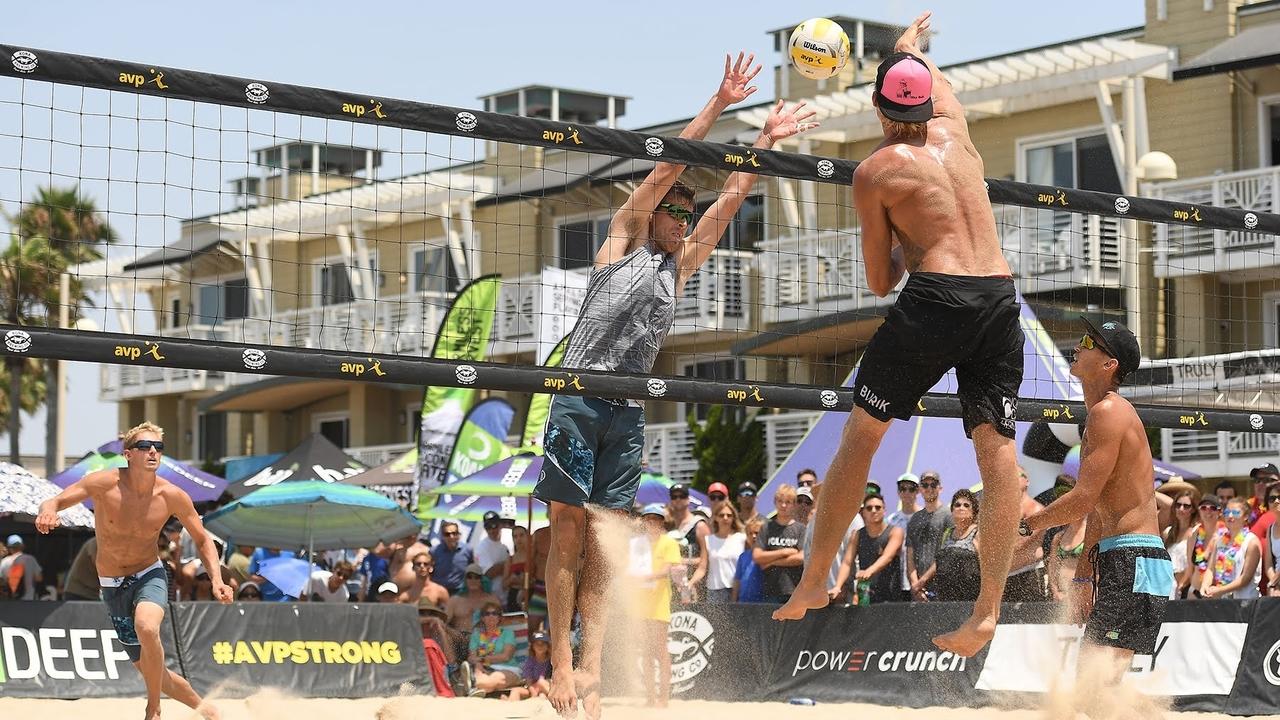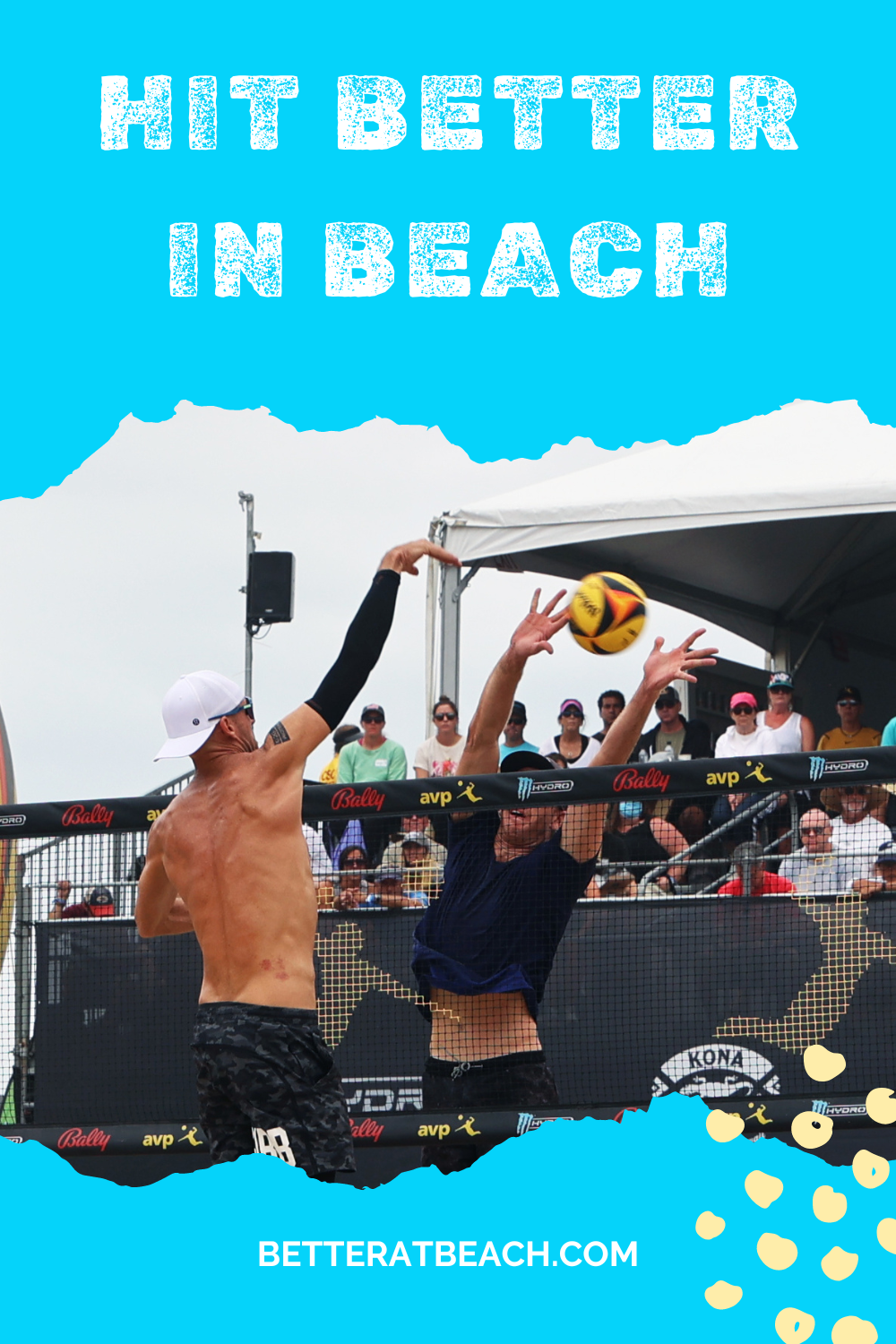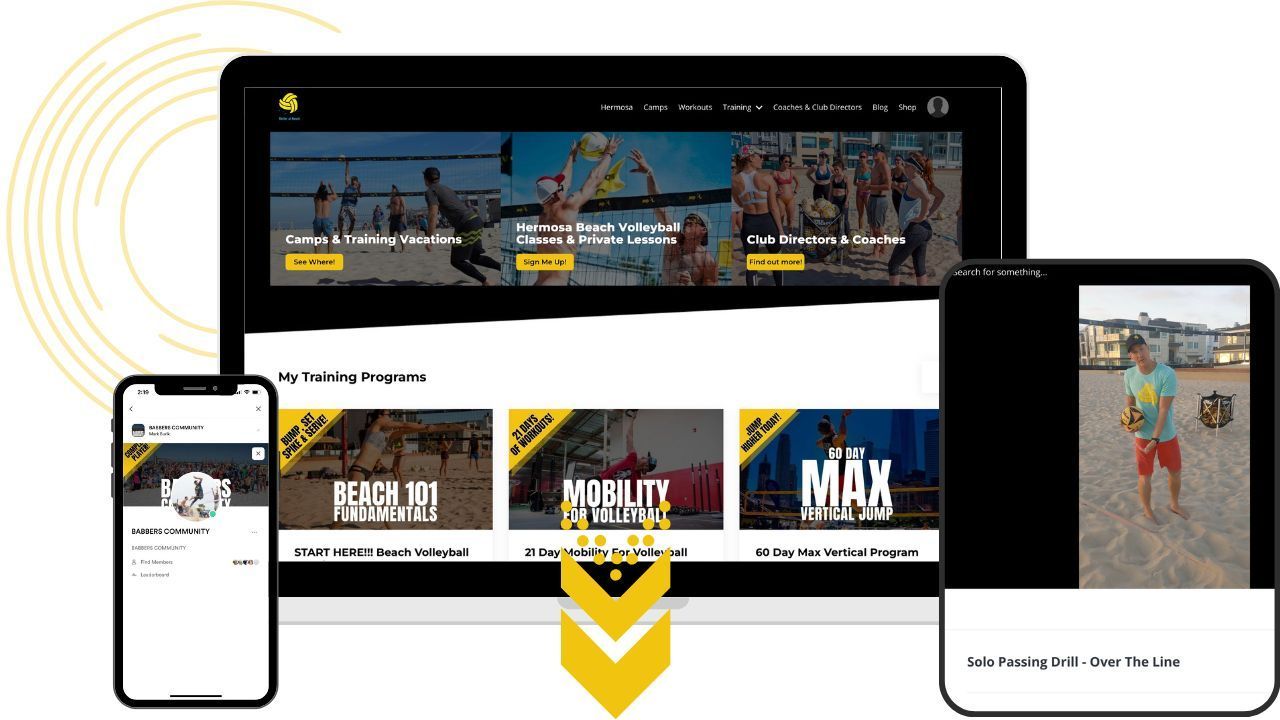
27 Beach Volleyball Hitting Drills Guaranteed to Make You a Better Attacker
Do you want to become a better attacker in beach volleyball? It can be an absolute pain to come up with drills and exercises that help you get better at hitting. Do you know the right things to work on? Are your drills game-like? Do they just give you something to do or do they actually help you score more points and win tournaments?
YouTube can be a nightmare in terms of actually collecting enough information to become actionable. I decided to create this post which assembles all of my favorite beach volleyball hitting drills. If you want to hit harder, get better vision, and get kills consistently, look no further than this post. You won't be able to do all of these at one practice so feel free to bookmark this post on your browser so you can refer to it again and again.
I LOVE feedback so use the comments or just send an email and let me know what you think or what you want more of!
Want to learn more IN PERSON and ON VACATION??
Our camps are designed to get you Better at Beach Volleyball...
Advanced Beach Volleyball Hitting Drill: Cross Court Over The Net Pepper
This is a basic drill that almost every professional team does. It’s a Cross Court Over The Net Pepper – basically we’re positioning two defenders and attackers diagonally from each other and we’re going to dig, set, and hit diagonally to the other team. We’d like to do this cooperative so we can go for a series of timed or repetitions in a row.
Just make sure you’re getting your footwork going, getting yourselves nice and warm, and being able to jump high and snap with some accuracy at the other team.
You can also do this line to line so you that you’re going parallel, and you can do it diagonal from both sides so that our left and right sides get worked.
There’s a lot of options with this drill, just make sure you’re getting the footwork into digging a nice ball, set a nice ball, and then snap at the other team accurately.
You can do this jumping or standing depending on how warm you are or what time you have in your practice.
6 Guns
One of our favorite drills to warm up with is 6 Guns. This drill is basically a test of who can react faster and do so cleanly and accurately.
1: Speed Pepper
We can initiate it with a Pepper where we pass, hit, set and spike low and fast and we're trying to test the edge of our partners speed limit
So if we end up controlling this without accelerating, then we're going to get a little too comfortable. We want you to move in an uncomfortable speed where you're really testing your ability to react.
2: Handcuffs
The next version of 6 Guns that we have is called the Handcuff 6 Guns. It means you're only able to Pass or Tomahawk. Make sure your hands never come apart and basically you're trying to tap your partner in the face, the nose, or the legs, or get it by them to the point where they can't react. The goal is to test speed limits without completely slamming your partner. This one helps with learning how versatile your tomahawk can as well as training to prevent you from getting six-packed.
3: One Hand
Our next version of 6 Guns involves just using one hand and being able to use it in all different shapes and ways so that it's available defensively, and then in terms of ball control.
If we're only locked into forearm passes and handsets, we're not taking full advantage of our body. We need to have everything available. If you've got a shoulder injury or surgery, this is this is a great drill for you. I did one handed drills like this for 3 months after my shoulder surgery and it opened my world of ball control.
You're going to keep one hand behind you, and being able to operate all around yourself using only one hand, just to open up a little bit of range defensively, and in terms of all any formation you want; Pokey, Slaps, Backhands, Forearms are fine, just make sure you can keep the ball alive.
Obviously, you can also do it with your left hand. Maybe you're going to be significantly worse with your non-dominant side, but we encourage doing it so that you can open up more windows for yourself.
Check out this beach volleyball drill. We use it all the time at our volleyball camps in Hermosa Beach, CA and our other beach volleyball trips.
Attack Vision – Short Over The Block
Sometimes in beach volleyball, we can feel open spots just by feeling or knowing where the blocker is. Normally, if a blocker is blocking line, it means the defender is sitting in the cross. Most teams won't double up very often because they get nervous about leaving an entire half of the court wide open.
To practice beating the blocker, we're going to come out of the middle as an attacker, and we're going to use the blocker as our signifier for where we should hit. Once the hitter gets the set into the middle of the court, the blocker (or coach or decoy) should shift to show the hitter that they should go over the block and get and get the ball all the way to the sidelines.
In this video I've drawn boxes about 10 feet off of the net because you need to get this ball far enough from the blocker so that they can't drop and pursue it. If you leave it right behind them, the blocker has a chance to land, turn and get their own dig. If you get it far enough behind them and far enough in front of the defender it makes it a really difficult ball to get.
3-Person Vision Pepper
The next beach volleyball hitting drill comes in the form of a three-man pepper. For those of you who might not know, 'pepper' means that we have a cooperative rhythm of dig, set, hit. We aren't trying to kill the ball and we want to keep the sequence going for as long as possible.
The middle person is going to be the setter. After the set and before the hit, the person who is about to play defense should put their hands up by their face or down by their thighs. The hitter’s job is to get to the set, get their feet perfect, find the high or low side and then deliver the high or low ball.
Watch it on this video and don't forget to click SUBSCRIBE on the bottom right.
Beach Volleyball Hitting Drills: Scoring in Tough Situations
In this video we've got a little transition setting and offensive decision-making drill to help your beach volleyball game. If you want to be a better attacker in volleyball, you NEED this one.
Check out the video to see what we did here. I'm coaching and on my side of the court we have four zones - two zones in the sharp sidelines, and two zones in the deep corners. The deep corners are going to be worth one point. The sharp side lines are worth two because those are more aggressive swings.
If the attacker hits it in the middle of the court where defense is going to be, then that's worth one for my side. Anytime the sideout team makes a hitting error, it's going to be worth three for my side.
So, their job as hitters is basically to make good decisions. As setters they need to create great fixing sets. I'm also forcing them to play the first ball with one arm because I want to work in some transition trouble sets. I want to create struggle because this is an advance team. So, I'm going to feed them, they have to get the first touch with one arm, and then they have to go for the correct swing. We'll see it for a couple of points here on this video.
Beach Volleyball Hitting Drills: Open Net Sideout for Accuracy
This drill video which is a part of our attacking course because it should be done at just about every practice. This is part of our every day skill maintenance. If you want to learn how to spike with accuracy, the first step is legitimately practicing accuracy.
It's shocking you have to hit accurately to score points in beach volleyball but so few people practice it. Imagine a basketball player who just threw balls near the basket but never actually spent time training to get the ball in the hoop. If you play outdoor volleyball whether it's grass volleyball or sand volleyball, START DOING THIS HITTING DRILL EVERY DAY!
You cannot ignore basic hitting accuracy.
We do this hitting drill at every practice at our home base, VolleyCamp Hermosa in Los Angeles. Come out and try our volleyball classes or take a private lesson to see what a REAL beach volleyball training session looks like!
Beach Volleyball Practice Plan for Hitting and Passing Footwork
Below, I show you what it's like to go through one of our advanced men's beach volleyball classes. I work with these guys twice a week and every one of them has seen their games hit new levels. A focused training program can do that. But you don't need to be in California to learn from us.
Not only do you get access to our entire library of drills but you get live access and video meetings with our pro's twice a month!
That's right! Two times a month, you have the opportunity to learn from FIVB World Tour players in a live video conference with the rest of our members. Ask all of your beach volleyball questions and get REAL detailed answers.
Best 2 Person Beach Volleyball Hitting Drill Ever!
When you can't get a full squad to practice, there is still PLENTY of live work you can get done on the court.
We set our sideline boundaries so that we have about 2 feet of space we need to hit in. Our deep corner swings are set up so they end two steps from the baseline. Make your boundaries as big as you want but CHALLENGE YOURSELF.
We also made the rule that our swings in the front half of the court HAVE to have DOWNWARD TRAJECTORY. This gives us feedback and tells us when we are in a position that ALLOWS US to go for the sharp swings.
It's not smart to try to bang the ball from every position and the court and we HATE loopy cut shots. If you get a great set, you can attack aggressively. If not, play smart and let the defense try to chase and convert.
As always you can set whatever rules and scoring you like but for us, our sharp swings in the front two thirds are worth two points. Our deep corner swings are worth 1 point and our hitting errors net us Minus 1. As a team we got to 11 points 4 times in today's practice. We initiated one match from each corner of the net so that our hitting drill tests our ability to side out no matter the sun and wind are.
I can think of no better way to have a long, focused, and beneficial practice with only two people. Check it out and then bookmark this page so that you can do this drill when your training partners bail on you!
Beach Volleyball Hitting Drill for VISION: Dig, Set, Look, Hit!
This drill is a great Coach on One drill. We have a specific serving target that our player needs to hit. If he or she hits that target then they're going to enter the court and they're going to play defense. The player will go through their entire defensive rhythm.
That means that they enter the court shaded middle and the the drill facilitator claps to signify that the setter is setting and not attacking. It's always important to mentally and physically train to defend the 'on-2' attack. After that, the coach/facilitator can throw the ball wherever they want.
Defenders should be initiating chases with crossover steps, so keep your footwork in mind as we're doing this. If you don't know what that looks like, check out our Defender Category in this blog.
When you chase the ball initiate with a crossover step, don't waste steps by opening your lead leg. After the defender pursues that ball this drill converts to a beach volleyball attacking drill. The player needs to pass to themselves and set to themselves. They should set because they need to look for the coaches sign before they hit. After the set and before the hit, the coach should point at a target. The hitter then needs to execute that swing into the right location. Deliver!
Look at this video from our beach volleyball YouTube Channel. If you haven't subscribed yet, go ahead and do that so we can keep making posts and videos like this.
Beach Volleyball Hitting Drill for Conditioning and Accuracy: Deep Middle Transition Attack for Time.
It is important every now and then to incorporate some type of conditioning into your volleyball training and this is an example of a drill that we can do while still playing volleyball.
Our player needs to hit a hard middle seam ball. The seam is basically the middle of the court. It's the small corridor between the players on the other side of the net.
After they hit that, they’re going to have to get behind a line that you can draw at either half court or three quarters depth. It depends how much you love conditioning ;)
In this hitting drill, we want to make sure that we get behind the line and drop to our knees. This simulates some sort of defensive action. As attackers, be sure not to rush to the net after you get up. Get to your feet, wait, see the set and then approach to hit. If you go in early, this drill will get ugly fast. Calmly take an approach from behind the ball and then smack that deep middle seam.
The deep middle hit will get you more points in your career than you'd ever believe could come from one desperate shot.
Solo Beach Volleyball Hitting Drill: Vision – then Fitness Vision
We’ve been getting a lot of requests for lonely or solo volleyball drills so I’m going to show you a drill that I've done since I was just a beginner. I didn't have access to any beach volleyball drills for beginners so I just made them up. I didn't realize that some of them would pay huge dividends in teaching me how to hit a volleyball properly but I'm happy to share them.
I've always use slanted roofs to pass to myself, set to myself and hit the ball on the roof. But I’m going to include something that has vision work. After you pass to yourself and set to yourself, between your set and your hit, you have to look forward at the wall and then back to the ball for the hit. In the video, I’ll make an exaggeration: Just watch my eyes, watch my head tilt, and you can get some vision work while you’re doing this.
If you’re trying to get a little fitness in, it would be a great idea to add a burpee while the balls rolling on the roof. If you’ve got an angled roof and you need a one person hitting drill for beach volleyball, give it a shot: burpee between every sequence.
Related: Ways to improve the effectiveness of your shots
Solo Beach Volleyball Drill: Setting
I didn't want to separate these videos so even though this a setting drill, we are going to include it in this post. Besides, what better way to become a great hitter than to recruit a great setter!?
This is an easy setting drill that trains setting footwork. If you’re learn footwork and you’ve got a ball and a hard surface with no ceiling, this is the setting drill for you.
We know that whatever side the net is on, that foot should be forward. So if the net is on my right, my sequence would be: left, right, set.
If the net is on my left, my sequence should be right, left, set.
Off foot, net foot, set.
Soft knees. Dip, dip, and lift.
Do this with a ball and have one bounce between each contact.
Try to get 100 on each side. Repetition breeds perfection.
Related: Basic setting drill: Pass, set, and catch
Solo Beach Volleyball Drill: Recovery
Here’s another beach volleyball drill you guys can do at home. This one is for ball control. You’re going to pass to yourself, you’re going to set to yourself, then you can use a head or a shoulder, but after the head or shoulder touch, you have to use one hand. You can’t use your forearm, it has to be your hand in between, and then it resets. So:
Pass
Set
Head or shoulders,
Hand
Repeat
Give it a shot and see if you can get 10 in a row.
Related: Are you fed up with passing and serve receive woes?
Solo Beach Volleyball Hitting Drill: Pokie Practice
Most people forget that the pokie can be an absolutely crucial part of your offense. Certain players, myself included, base their offensive scheme around this attack.
A lot of people hold them differently but what you want to focus on is hitting the second segment of your fingers. If you can keep this straight line from your wrist to the second knuckle from your finger tip, that’s going to be where your pokie has its power.
Spread the surface area and use almost the entire face of the second segment of your fingers. From there, you just need stiff, hyper extended fingers and a strong wrist.
Solo Beach Volleyball Hitting Drill: Fix Your Volleyball Arm Swing Mechanics by Throwing a Tennis Ball
I want to help you fix your arm swing from home, and we’re going to do it using a tennis ball. There are two ways to give yourself a bigger hitting window.
One of them is by rotating through the torso. If you can keep your hips and feet facing forward while rotating your shoulders back, you've got great thoracic mobility which is crucial for hitting harder.
You can get a feel for this by taking your right hand and pushing from your right butt cheek. Use that leverage to open your chest. That’s one way to open up using your thoracic and that’s really important because the stretch across the oblique helps you generate torque and power. The other way to open up that hitting window is by using your rhomboids. Try to squeeze your shoulder blades together. The muscles that do this are your rhomboids. This has to activate on your hitting arm before you attack if you want a massive hitting window and a powerful arm swing.
Want to show your support and help us make more content?
Check Out Our Volleyball Favorites...
 |
|
|---|---|
| Baden Champions Volleyball Set Blue |
The first thing that we’re going to do is practice our load sequence. So if I’m going to throw towards my 12 o’clock, I’m going to turn my feet to about 10:30. Both my feet are facing towards 10:30. So I’m going to rotate my back first, then I’m going to open using my rhomboids, or I’m going to pinch my shoulder blades back so I open my arm's range of motion. So, open thorasic, then I load my arm by squeezing my shoulder blades together a little bit.
Before we go onto throwing, we have to know there’s a sequence for the arm swing. Keep your hand high and away. From there, with this part of your elbow facing backwards, my next move is to bring my elbow up, so that this part of my elbow faces directly up so my hand is back. So that takes external rotation. So if you can get your elbow up, face a mirror and see if you can see your hand on both sides of your bicep. That takes external rotation. If you can’t get there, you need to do a little range of motion work. So once I’m back, and this part of my elbow points up, and my hand is back, that is when I can release to the wall. So you need a tennis ball and you need a wall, but there’s five stops here.
I’m at 10:30, I’m opening my chest, my hips stay locked, my toes stay on the ground, and I open my torso. From there, I open my arm using my rhomboids, using my shoulder blade muscles. From there, now this part of my elbow is pointing back. I release from that high elbow point.
In the beginning, I want you to take 10 of them and hit every stop. 10:30, thoracic, shoulder blade, elbow high, then release.
Get that sequence down and let’s get 100 throws today with a tennis ball. If you want me to take a look at it, I want you to post it and I want you to tag me. Hopefully you can show it in slow motion, but tag me, send it in slow motion, use the sequence: torso, shoulder, elbow high, hand follow through.
Easy enough?
Good luck!
Related: Maximize space for your hitting arm!
With 30 day money back guarantees, you can't lose!
How to hit a volleyball with accuracy: Self-toss Target Practice
This is a great warm-up drill when you're starting to get your arm loose. It won't get you any game-like reps, but it's really important to be able to control the ball with vision. So, you're going to toss to yourself -make sure that you toss well above the top of the antenna- after you follow where the ball is, then your eyes need to drop or focus on your partner.
After the peak of the ball, your partner is going to put one hand anywhere they want. Your job is to reach to the top of your swing and try to snap the ball to their hand on that line. All they need to do is catch the ball and it's their turn. So, they toss above the top of the antenna, find the ball, find the target, find the ball again, and snap to that hand that's open.
Feet to Ball: Footwork drill for hitting in beach volleyball
We got a question a while back in our VolleyChat Forum from a coach in Virginia Beach.
"Coaching some U-16 girls and the smaller girl has a hard time seeing/adjusting to a tight set (not necessarily a bad set just tighter than usual). Got any drills to improve her last two steps of approach to be able to make an aggressive attack on the tighter sets?"
We're happy to answer questions like this for our members and in fact, I filmed this video the next day just because he asked!
It sounds like a lot of her problems can be fixed with some feet to ball work. For the most part I like to practice full skills so you should just keep having her pass, set, hit and then show her where she took off from and where she landed. You want to focus on landing in the same spot you take off from but eventually, make sure you know that it's ok to broad jump a little bit on the sand. It will just be less than indoor volleyball players do.
I also like to use the drill shown below to help players understand the importance of the 2nd step in a four step approach. Alex and Julia came to our beach volleyball training camp from Munich and had only just started playing a few months before that. Our volleyball vacations are open to beginners and advanced players alike.
It's important for players to understand these concepts early.
We have three targets set up where our players must take off and jump from.
Our first two steps are always in the same spots but our last two (or STEP CLOSE) have 3 different locations to simulate an outside set, a perfect set and an inside set.
This is a great way to help beginner beach volleyball players understand that they can change speed and direction DURING their approaches.
Controlled Hitting Drill: Hitting with Control
Here's an awesome drill that you can do with a partner who's got good quality defense. Even if you're a parent and you don't play volleyball at all, you can help kids get better using this exercise.
Player A has three touches. They have to pass to themselves, set to themselves, and then hit at Player B. If Player B is a parent or someone who doesn't play volleyball, they can just catch the ball. If you can catch it, that qualifies as a good hit from the Player A.
Just throw it back and Player A can go through the sequence again and again until they can control the ball with all three touches.
If you guys are both experienced players, then one person is only digging every time and the other person is passing, setting and hitting. Once you get to a really advanced level, the hitter is going to jump. So we're going to show you all three versions in the video below.
Beach volleyball partner drill: Pass, Set, Spike vs. Defense
This is the second progression of our pass, set, spike and defense drill. One player is a passer, setter and hitter. The second player is ONLY a defender.
Player A gets 3 touches in a row and Player B gets 1 touch. Player B who has one touch is only responsible for digging high.
Player A should pass to herself, set to herself, and spike to her partner.
Do not let the ball fall!
Drill for Hitting Accuracy and Defensive Reactions
So this next drill is to train your defensive reactions. If you're looking for a player to watch for this, Katie Spieler is the one. It doesn't help you with vision work, but it does help you with your preparation. So the position that you should be in: When you're waiting, get your hands out in front of you. Have your partner behind you. Roll the ball against the wall, dig it to yourself. Pass it to yourself. Set it back to them. And if you're super fast, let them hit the wall again. See how it works.
Next-Level Beach Volleyball Ball Control Drills: Emergency Touch Series to Attack
This is a great partner drill to warm up our ball control touches, as well as our defensive movements. We're going to incorporate a pass, a tomahawk, and a pokey, all in a defensive or ball control nature. That means, we should get the ball high enough where a setter would have time to get under the ball and make a controlled play.
As his partner, I'm going to start the drill by tossing a deep ball which he passes with his forearms.
Next, I'm going to set him the deep ball which he should tomahawk.
Finally, I'm going to set him a deep ball which he has to poke.
Remember, all of these touches should get the ball high and within 10 feet of the net.
From that pokey, and without catching, we're going to set and hit out of it into a designated target.
Watch it on this video.
Pepper Drill for Hitting Accuracy, Vision and Defense.
This one is self explanatory. This advanced pepper drill requires quality digs, vision and accuracy. You only have two touches to dig, see the defense and hit to the right spot.
Drill for Hitting The High Line in Beach Volleyball: The High Line Challenge
In the video, we draw 2 high line boxes. This is video is mainly of a serve receive practice, but we turned it into a light hitting drill. The winner is the first person to get 4 high lines, but we're doing it with a plus or minus scoring.
If we miss the high line, we miss that box at any point - it becomes a minus, if we get it - it becomes a plus.
You can see we've also added a bungee cord across the net. The net level helps Ian because he's the one who's trying to hit flat float serves that cross the net really low. That puts more pressure on the other team.
For Paul and I, the bungee cord is there to ensure we get that ball up and over a blocker. You have to clear the blocker for it to be a legitimate high line.









